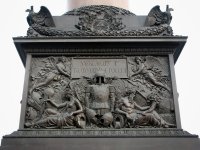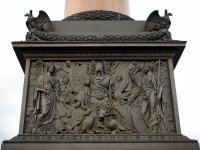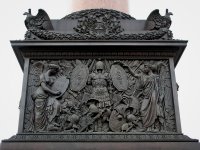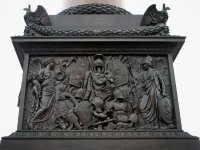I'm currently working on a separate article. This thing kind of came up in the process. It's been bugging me for a while, because I might have an idea of what kind of baloney could be up. Anyways, here is what we have.


Back: Google translated. A battle scene is depicted on the reverse side of the pedestal.

I can ignore the pagan Medusa on the shield. But what are we gonna do with Mr. Pozharsky in 1612 wearing a helmet looking way too similar to the one worn by Alexander Nevsky or Tsar Michael the First?

Nowadays, the helmet is stored in Kremlin Armoury and treated as one of its most valued artifacts.

A gentleman in the article below did a semi-decent speculative job of "proving" why this helmet could never belong to Alexander Nevsky:
For whatever reason, my google translate stopped working, but from what I can deduce, the narrative also wants us to think that this helmet did not belong to Alexander Nevsky.

Below you can see one of the helmets depicted on the Alexander Column pedestal. I was unable to exactly figure out what's where, but here is what we have:

Which Alexander I?The Alexander Column also known as Alexandrian Column, is the focal point of Palace Square in Saint Petersburg, Russia. The monument was raised after the Russian victory in the war with Napoleon's France. The column is named for Emperor Alexander I of Russia, who reigned from 1801–25.
The Three CrownsThere are three distinctive crowns on the helmet. There are not too many coats of arms out there sporting three crowns on. One of the most obvious would be the coat of arms of Sweden.
Pharamond, also spelled Faramund, is a legendary early king of the Franks, first referred to in the anonymous 8th-century Liber Historiae Francorum, which depicts him as the first king of the Franks.

Some food for thought: Ferdinand of Tyrol in Hungarian Tournament attire.

KD: I do not know who exactly we have wearing the helmet, but I doubt it was Pozharsky.

P.S. Them historical doubles and triples don't make it easy on us... and the time line is all screwed up.
Monument to Minin and Pozharsky
The Monument to Minin and Pozharsky is a bronze statue designed by Ivan Martos and located on the Red Square in Moscow, Russia, in front of Saint Basil's Cathedral. The statue commemorates Prince Dmitry Pozharsky and Kuzma Minin, who gathered an all-Russian volunteer army and expelled the forces of the Polish–Lithuanian Commonwealth under the command of King Sigismund III of Poland from Moscow, thus putting an end to the Time of Troubles in 1612.- Minin: died in 1616
- Pozharsky: died in 1642
- Time of Troubles: 1598-1612
- The competition for the best design was won by the celebrated sculptor Ivan Martos in 1808.
- Martos completed a model, which was approved in 1813.
- Casting work using 500 kilograms (1,100 lb) of copper was carried out in 1816 in St Petersburg.
- The base, made of three massive blocks of granite from Finland, was also carved at St Petersburg.
- However, in the wake of Napoleon's invasion of Russia, the monument could not be unveiled until 1818.
- The bas-relief is dedicated to the victory of the people's militias led by Prince Pozharsky.
- The plot is also divided into two parts.
- On the left, the Poles fleeing from Moscow, looking with horror at the victors, on the right Pozharsky, leading the brave warriors, tramples on horseback and drives the enemy away with a sword.
I can ignore the pagan Medusa on the shield. But what are we gonna do with Mr. Pozharsky in 1612 wearing a helmet looking way too similar to the one worn by Alexander Nevsky or Tsar Michael the First?
- or by both...
- or by neither...
The Jericho Helmet
Well, there is thi narrative, but it still does not explain why Pozharsky has a similar one on. The helmet was crafted in 1621 by Nikita Davydov for Michael I, the king of Moscovia. It was used as a parade attribute to Michael's dress. After Moscovia has been renamed to Russian Empire, the helmet was depicted on coat of arms of the Russian Empire.Nowadays, the helmet is stored in Kremlin Armoury and treated as one of its most valued artifacts.
- Russia Armoury Moscow Kremlin art card damascus helmet the Jericho hat
- Helmet related discussion
- Helmet ‘Jericho Cap’. Craftsman: Nikita Davydov. 1621
- Translation: Why "Alexander Nevsky's Helmet" never belonged to him.
- The helmet was allegedly produced in 1621 by the master Nikita Davydov for Mikhail Fedorovich Romanov.
- Fedor Grigoryevich Solntsev was a Russian painter and historian of art.
- 1801-1892
- His artwork was a major contribution in recording and preserving medieval Russian culture, which was a common subject of his paintings.
- He was the main author of the fundamental work Antiquities of the Russian State, the main decorator of interiors of the Grand Kremlin Palace in Moscow.
For whatever reason, my google translate stopped working, but from what I can deduce, the narrative also wants us to think that this helmet did not belong to Alexander Nevsky.
Three Crowns
This particular helmet has three distinctive crowns. It is the only helmet to have those. On the bas-relief we can clearly see one of those crowns. Naturally, what we have is a helmet that was not even made yet, placed on a head of a person who could not have it on, even if the helmet did exist in 1612.Below you can see one of the helmets depicted on the Alexander Column pedestal. I was unable to exactly figure out what's where, but here is what we have:
- The pedestal of the Alexander Column is decorated with symbols of military glory, sculpted by Giovanni Battista Scotti.
- On the side of the pedestal facing the Winter Palace is a bas-relief depicting winged figures holding up a plaque bearing the words "To Alexander I from a grateful Russia".
- The composition includes figures representing the Neman and Vistula rivers that were associated with the events of the Patriotic War.
- Flanking these figures are depictions of old Russian armour - the shield of Prince Oleg of Novgorod, the helmet of Alexander Nevsky, the breastplate of Emperor Alexander I, the chainmail of Yermak Timofeyevich and other pieces recalling heroes whose martial feats brought glory to Russia.
- Source
- Compare to Mr. Nevsky here.
Which Alexander I?
- Below we have all four sides of the pedestal.
- Question: what does any of this have to do with the war of 1812?
- The narrative compliant one, or the one below?
The Three Crowns
Pharamond, also spelled Faramund, is a legendary early king of the Franks, first referred to in the anonymous 8th-century Liber Historiae Francorum, which depicts him as the first king of the Franks.
KD: I do not know who exactly we have wearing the helmet, but I doubt it was Pozharsky.
- Whoever did the bas-relief, made sure to depict a visible from that angle crown on the helmet. Sounds like this element was important.
- Any thoughts?
P.S. Them historical doubles and triples don't make it easy on us... and the time line is all screwed up.
- By the way, do we have any coins issued during the reign of Alexander I where his head is depicted on the obverse?





